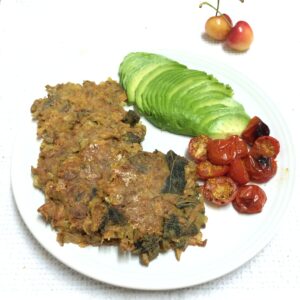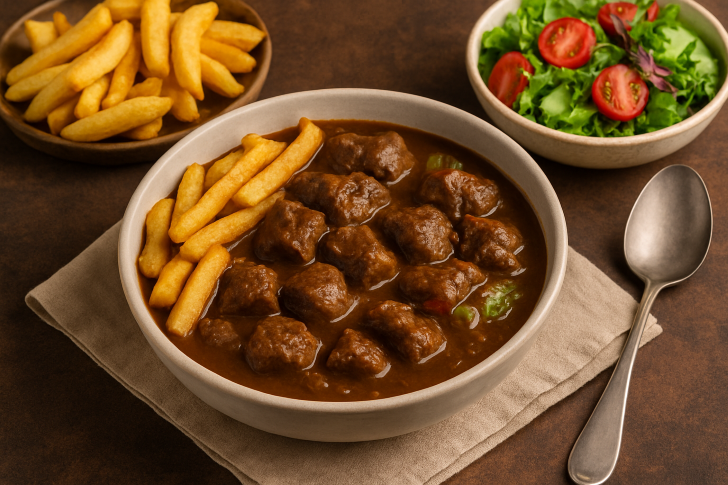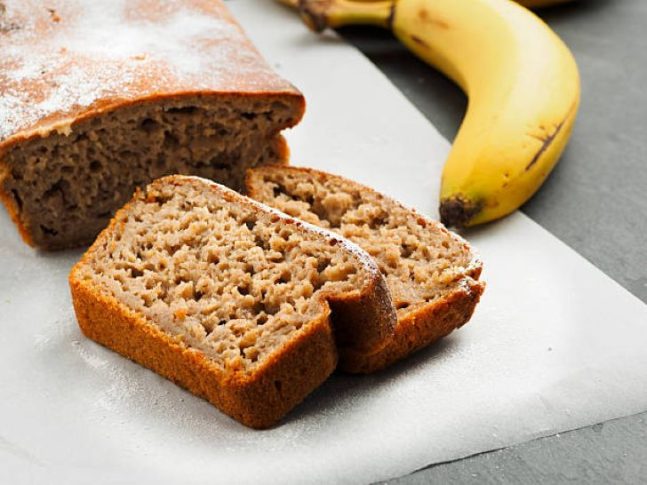Make Traditional Bean Sandwich Senegal Recipe at Home

Did you know that some of Africa’s most beloved street foods aren’t fancy dishes, but simple, satisfying sandwiches?
Meet Ndambe, the hearty bean sandwich that’s a cornerstone of traditional Senegalese food. This humble yet flavorful creation combines perfectly spiced black-eyed peas with crusty baguettes, creating a portable feast that feeds millions across Senegal daily.
From bustling street corners in Dakar to family kitchens across the country, this protein-packed sandwich has been satisfying hungry Senegalese for generations. While it might look simple, making an authentic Ndambe requires specific ingredients, techniques, and cultural know-how.
Ready to master this classic Senegalese sandwich in your own kitchen? Let’s explore how to create this beloved street food, step by step.
Understanding Ndambe’s Cultural Significance
The story of Ndambe reflects the rich tapestry of Senegalese culinary heritage, where traditional ingredients meet colonial influences. Originally a dinner staple in Senegalese households, this hearty dish evolved into a beloved breakfast sandwich that perfectly exemplifies the nation’s food culture.
History of Senegalese Bean Sandwiches
Ndambe’s journey from a humble “country people’s food” to a celebrated street food staple mirrors Senegal’s own cultural evolution. The fusion of French colonial influence, evident in the ubiquitous baguette, with local ingredients created this unique culinary tradition. After Senegal gained independence in 1960, Ndambe emerged as a symbol of cultural resilience, combining French-influenced bread with distinctly Senegalese flavors.
Regional Variations and Traditions
Every corner of Senegal has its own interpretation of Ndambe, with variations that reflect local tastes and traditions. Common regional adaptations include:
- Vegetarian versions with aromatic spices and vegetables
- Meat-enhanced variations featuring lamb or beef
- Sweet potato enriched preparations
- Versions incorporating okra for added texture
Key Ingredients and Their Importance
The heart of Ndambe lies in its carefully selected ingredients, each carrying cultural significance. Black-eyed peas, the star ingredient, hold particular importance in West African culinary heritage. These peas, which traveled to the Americas during the slave trade, have become a powerful symbol of African culinary influence across the diaspora.
The dish’s foundation rests on locally grown ingredients, including tomatoes and potatoes, celebrating Senegal’s agricultural bounty. The spice blend, featuring garlic, bay leaves, and chili powder, creates the distinctive flavor profile that has made Ndambe a cherished part of traditional Senegalese food culture.
Today, countless tangana and street vendors across Dakar and other urban centers serve Ndambe sandwiches to locals rushing to work or school. This transformation from a simple home-cooked meal to a convenient street food demonstrates how traditional dishes adapt to modern lifestyles while maintaining their cultural essence.
Essential Ingredients for Authentic Ndambe
Creating an authentic Ndambe begins with gathering the right ingredients, each playing a crucial role in developing its distinctive flavor profile.
Traditional Spices and Seasonings
At the heart of Ndambe’s aromatic profile lies a carefully balanced blend of seasonings. Red palm oil, a traditional ingredient, imparts a distinctive deep red hue and unique carroty flavor notes to the dish. For those concerned about sustainability, look for responsibly produced palm oil, or substitute with vegetable oil as an alternative.
Essential spices include:
- Minced garlic cloves
- Ground chili powder
- Bay leaves
- Tomato paste for depth
- Salt and black pepper to taste
Choosing the Right Beans and Bread
Black-eyed peas form the foundation of any authentic Ndambe. While dried beans are traditional and provide the best texture, canned varieties can work in a pinch. When selecting bread, opt for baguettes with a soft, tight crumb rather than overly crusty varieties. This texture allows the filling to integrate better with the bread rather than squeezing out with each bite.
Optional Add-ins and Accompaniments
The beauty of Ndambe lies in its versatility, with numerous traditional variations enriching its basic recipe. Consider these authentic additions:
| Core Add-ins | Protein Options | Vegetable Additions |
|---|---|---|
| Sweet potatoes | Lamb | Okra |
| Onion sauce | Beef | Bell peppers |
| Sosu Kaani (pepper sauce) | Mushrooms (vegetarian option) | Tomatoes |
For an extra layer of flavor, many vendors include mayonnaise or a spicy chili sauce. The traditional Sosu Kaani, a Senegalese pepper sauce, adds an authentic touch to your sandwich. Some variations also incorporate fried eggs or potatoes for added substance.
Remember that while these ingredients create the foundation of Ndambe, the key to authenticity lies in balancing these elements to achieve that characteristic traditional Senegalese food profile that has made this dish a beloved staple across generations.
Preparing the Traditional Bean Filling
The heart of any great Ndambe lies in perfectly prepared black-eyed peas and a rich, flavorful spice base. Let’s master the traditional preparation method that makes this Senegalese sandwich filling so irresistible.
Soaking and Cooking Black-eyed Peas
While canned beans offer convenience, dried black-eyed peas provide the authentic texture that traditional Senegalese food is known for. Here’s the proper preparation method:
- Sort and rinse the dried beans thoroughly
- Soak beans in water (covering by 4 inches) for 1-2 hours
- Drain and rinse again under cold water
- Cook in fresh water without salt for about 45-60 minutes
- Test for tenderness, ensuring beans are firm but fully cooked
Pro tip: Avoid adding salt during the initial cooking phase, as this can toughen the beans. Season only when the beans are nearly tender.
Creating the Spice Base
The aromatic foundation gives Ndambe its distinctive flavor profile. Begin with a hot pan and follow these steps:
Heat your chosen oil until shimmering, then add:
- Finely diced onions (cook until light golden brown)
- Minced garlic and chilies
- Bay leaves for depth
- Tomato paste (allow it to caramelize slightly)
The spice base should simmer until it develops a rich, deep color and the aromatics have softened completely.
Achieving the Perfect Consistency
The ideal Ndambe filling should be thick enough to spread on bread without being too wet or too dry. Here’s how to achieve the right texture:
| Cooking Stage | Consistency Check |
|---|---|
| Initial Simmer | Brothy and loose |
| Mid-cooking | Slightly thickened |
| Final Stage | Spreadable paste |
For the perfect sandwich-ready consistency, continue cooking uncovered until most liquid has evaporated. The filling should be thick enough to hold its shape on bread but still moist enough to be flavorful. If using sweet potatoes, they’ll naturally break down during cooking, helping to thicken the mixture.
Important: The filling will continue to thicken as it cools, so it’s better to err on the slightly looser side when removing from heat. For the best results, let the mixture rest for 10-15 minutes before using it as a sandwich filling.
Mastering the Assembly Process
Assembling the perfect Ndambe sandwich is where artistry meets tradition in this beloved street food. In the bustling streets of Dakar, skilled vendors have perfected the art of creating these satisfying handheld meals that have become an integral part of traditional Senegalese food culture.
Selecting and Preparing the Baguette
The choice of bread can make or break your Ndambe sandwich. While crusty French baguettes might seem traditional, experienced vendors know that softer-crumbed baguettes actually work better. The ideal bread should have:
| Characteristic | Reason |
|---|---|
| Soft interior crumb | Prevents filling from squeezing out |
| Light crust | Easier to bite through |
| Fresh, day-of bread | Best texture and taste |
Proper Filling-to-Bread Ratio
The secret to a perfect Ndambe lies in achieving the right balance between bread and filling. The thick consistency of the bean mixture should act as a natural adhesive, helping to seal the sandwich together. Follow these assembly steps:
- Split the baguette lengthwise
- Spread a thin layer of spicy mayonnaise on both sides
- Add a generous but controlled portion of warm Ndambe filling
- Press gently to allow the filling to settle
- Ensure the filling reaches the edges for consistent flavor
Pro tip: The filling should be warm but not hot when spreading, as this helps it adhere better to the bread while preventing sogginess.
Traditional Wrapping Techniques
In Senegal, street vendors have mastered the art of wrapping these sandwiches to maintain their integrity and temperature. The proper technique ensures that your Ndambe remains:
- Portable and mess-free
- Warm until consumption
- Structurally sound for one-handed eating
The traditional method involves wrapping the sandwich in foil, which serves multiple purposes. It keeps the sandwich warm, prevents spillage, and allows the flavors to meld together as the bread slightly steams. This technique creates what locals recognize as the perfect “street-food” consistency, where the juicy stew acts as a natural binding agent between the bread layers.
For home preparation, you can replicate this authentic wrapping method by using aluminum foil and allowing the sandwich to rest for 2-3 minutes before serving. This brief resting period allows the filling to settle and the flavors to integrate fully with the bread.
Remember that while the basic sandwich is simply Ndambe between bread halves, many vendors offer customizable options. You can follow their lead by providing additional condiments or toppings, always ensuring they complement rather than overwhelm the primary flavors of your carefully prepared filling.
Serving and Storage Tips
Mastering the art of serving and storing Ndambe ensures you can enjoy this traditional Senegalese food at its best, whether fresh from the pot or as convenient make-ahead meals.
Traditional Serving Methods
While Ndambe traditionally graces breakfast tables across Senegal, its versatility makes it perfect for any meal of the day. In authentic Senegalese settings, the experience often begins with a visit to the local bakery for fresh baguettes, followed by a stop at your favorite Ndambe vendor.
For the most authentic presentation:
- Serve the sandwich warm, cut diagonally for easy handling
- Add a bright squeeze of lemon juice before serving
- Include a crunchy side salad for textural contrast
Making Ahead and Reheating
The beauty of Ndambe lies in its make-ahead potential – the flavors actually improve with time. The bean filling can be stored in an airtight container in the refrigerator for several days. For optimal results when preparing ahead:
| Storage Method | Duration | Tips |
|---|---|---|
| Refrigerated Filling | 3-4 days | Store separately from bread |
| Assembled Sandwich | Same day | Wrap in foil for freshness |
| Frozen Filling | Up to 1 month | Thaw overnight in refrigerator |
When it comes to reheating, several methods prove effective:
- Oven Method (Recommended):
- Preheat to 300°F
- Wrap sandwich in foil
- Heat for 10-15 minutes for optimal results
- Microwave Method (Quick Option):
- Place on microwave-safe plate
- Heat in 30-second intervals
- Cover with damp paper towel to prevent drying
Accompaniment Suggestions
Traditional Senegalese accompaniments elevate the Ndambe experience. Consider serving your sandwich with:
- Attaya – The ritualistic Senegalese tea service
- Fresh juices like:
- Bissap (hibiscus)
- Ginger
- Bouye (baobab fruit)
- Mango
For an extra kick of flavor, consider adding Sosu Kaani, the traditional Senegalese chile sauce. This spicy condiment perfectly complements the rich, hearty flavors of the bean filling.
Pro tip: When serving for gatherings, consider setting up a “build-your-own” station with various accompaniments, allowing guests to customize their sandwiches while maintaining the traditional essence of this beloved Senegalese street food.
Remember that temperature plays a crucial role in the serving experience. The filling should be warm enough to be flavorful but not so hot that it compromises the bread’s texture. This balance is key to achieving the authentic street food experience that has made Ndambe a cherished part of Senegalese culinary tradition.
Conclusion
Ndambe stands as a testament to Senegal’s rich culinary heritage, blending simple ingredients into a beloved street food that nourishes millions daily. This hearty bean sandwich proves that authentic traditional dishes can adapt to modern lifestyles while preserving their cultural essence.
Success with Ndambe relies on respecting traditional preparation methods while allowing room for personal touches. Quality ingredients, proper bean preparation, and careful assembly transform basic components into a satisfying meal that captures genuine Senegalese flavors.
Remember that practice makes perfect when crafting these sandwiches. Start with the basic recipe, master the techniques, then experiment with regional variations and accompaniments. Your kitchen can become a small corner of Senegal, producing authentic Ndambe sandwiches that would make any street vendor proud.
Whether served fresh for breakfast or prepared ahead for busy weekdays, Ndambe offers a delicious way to experience traditional Senegalese food culture right at home.
You might also like: 15 Best Sides to Serve With Pulled Pork Sandwiches







2 Comments